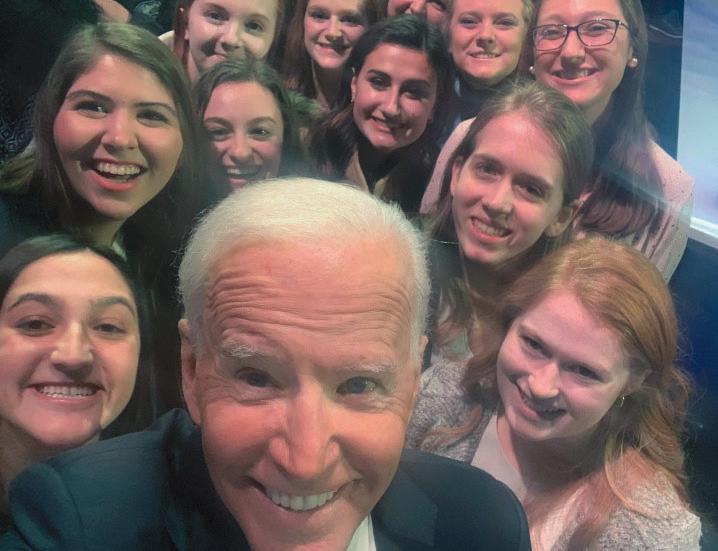
22 minute read
Cover Story
Robust academics, inspiration, engagement, and care. At The Steward School, this mission shapes every decision affecting our student body. Whether developing curricula, planning community celebrations, maintaining budgets, or creating lunch schedules, we keep ourselves grounded by placing community well-being at the center of each choice we make. But no matter how dedicated we remain to our mission, sometimes we are confronted with situations that challenge our traditional notions of how we bring “care” to life.
The COVID-19 pandemic presented one such dilemma. Or, rather, a series of them. "We're educators and school administrators, not health experts or crisis managers," Associate Head of School Lisa Dwelle said, describing the diversity of logistical hurdles facing the school when a national emergency went into effect on March 13, 2020. Following Governor Northam's closure of all state schools shortly afterward, Steward finished the 2019-20 school year with a fully online experience, suspending all in-person interactions for the next five months.
"It was just eerie," Head of School Dan Frank said, describing the empty grounds. Although campus life appeared idle, board members, school administrators, faculty, and staff were working tirelessly behind the scenes to make sure we were ready to open the campus to families at the start of the 2020-21 school year.
"We had a strategic vision to get these kids back in the classroom safely," Mr. Frank said. "We weren't exactly sure what that would look like, or if we could entirely commit to our vision, but we knew that having the opportunity to be together again was paramount."
We consider ourselves extremely fortunate to be in the position to have offered in-person learning this year as well as a Synchronous At-Home Learning (SAL) option. Our small class sizes, our sprawling campus, and our dedicated faculty and staff all factored into our opening this year, as did an abundance of good fortune. In the following pages, we look back at the detailed preparations that allowed Steward to safely resume school in person and on mission in the fall of 2020.
ALL HANDS ON DECK
The phrase "spring break" conjures sunglasses, crowded beaches, and breezy vistas. Those images stand in stark contrast to the signage posted on all building entrances leading up to last year's spring break requesting that people who had recently traveled to COVID-19 hotspots not enter and instead follow self-quarantine guidelines. Families were advised to share any illness information with school nurse Rebecca Heck, who would pass it along to the Virginia Department of Health (VDH) anonymously, and faculty and staff were preemptively trained on the technology needed for program and business continuity in the event of a school closure. When faculty, staff, and students left for spring break on March 6, the atmosphere was anything but relaxed.
"I don't think any of us knew what to expect heading into break," Mrs. Dwelle said. "We felt as ready as we could be given the circumstances, but there was still so much uncertainty."
COVER STORY
Steward had published its first COVID-related communication a week prior on February 28, outlining the latest advice on preventing the virus's spread from the Centers for Disease Control and Prevention (CDC), the World Health Organization (WHO), and the VDH. Even then — two weeks before the national emergency went into effect, and nearly a month before Governor Ralph Northam ordered all Virginia schools to close for the remainder of the school year — Steward questioned whether enough was known about COVID-19 to safely commit to on-campus learning in the next school year.
"We believe the Steward community is wellprepared," Mr. Frank wrote in his letter to families. "Nonetheless we have built a team (administrators, deans, IT staff, and health providers) to plan for different scenarios. These possibilities include managing ongoing learning for quarantined students, providing teaching and learning in the event of a long-term school closure, developing standards for visitors to campus who have recently traveled abroad, and providing for business continuity in the case of quarantine or closure."
The Task Force Mr. Frank described above held its first COVID-19-specific meeting on February 24 and continued to meet every day via Zoom, sometimes upwards of four hours at a time, for months on end. Discussions touched on every topic related to the school, from salvaging the spring sports season to what language should be included in "out-of-office" email messages and everything in between. Board of Trustees Chair Dan Campbell recalled those early days as "all-hands-on-deck."
"We reconsidered everything," Mr. Campbell said. "It wasn't just about how to continue educating kids, but rather how to exceed the minimum health and educational standards in ways that reflect Steward's mission."
TEAMWORK MAKES THE DREAM WORK
Steward's Task Force pulled in administrators from all across the school, eventually growing to include Mr. Frank; Mrs. Dwelle; Mr. Campbell; Board ViceChair Molly Anderson; Division Directors Ingrid Moore, Susan Atkinson, and Adam Seldis; school nurses Rebecca Heck and Heather Sams; Executive Assistant Stephanie Bowlin; Director of Technology Shahwar Qureshi; Controller Dena Dickson; Director of Plant Operations Chad Montgomery; Director of Marketing and Communications Rachel Williard; and Director of College Counseling Heather Jeter. Initially, the group's focus was to keep school operating for the handful of months remaining in the 2019-20 school year. "The triaging phase," as Mr. Campbell described it.
During this period, the Task Force aligned on addressing the immediate educational and financial implications of potential long-term closures. Top priorities included securing a Paycheck Protection Program (PPP) loan to keep operations running, equipping faculty to teach remotely, and ensuring students and families felt supported through such dramatic changes. Simultaneously, Mr. Frank and the rest of the Task Force spent hours educating themselves on a virus about which very little was known. That meant making decisions informed by reliable data — and lots of it.
"It's easy to get tongue-tied with all the acronyms," Mr. Campbell said, referring to the group of local, state, and national authorities The Steward School consulted or collaborated with. Among them, the U.S. State Department, WHO, CDC, and VDH, as well as the Virginia Association of Independent Schools (VAIS), the National Association of Independent Schools (NAIS), the Virginia Council for Private Education (VCPE), the Southern Association of Independent Schools (SAIS), and the Virginia Independent Schools Athletic Association (VISAA). The VDH's COVID-19 dashboard was particularly
instrumental in helping Mr. Frank set what he calls "flag numbers," or thresholds by which Steward would "tap the breaks, reconvene, and discuss the implications of those numbers."
The more the Task Force considered offering 100% distance learning, the more data they found suggesting that being in school, in person, affects every part of the student: their engagement, their social acclimation, their mental health, and their overall well-being.
"It's indisputable," Mr. Frank said. "The needs of students are best met through face-to-face instruction; peer interactions; musical and artistic performances; competitive athletics; and loving, supporting faculty. There are other needs that can be met, and we can meet some of those needs virtually, but the love that you get when in proximity to another person who loves you is a big deal."
Mr. Frank soon pulled together another group to look beyond the short term toward the summer and fall. This mix of past and current board members tasked themselves with devising a strategic road map by which the entire school could join forces to reach Steward's overarching goal: returning to inperson learning in the fall with options for remote learning. By late June, plans were already well underway.
REBUILDING A SCHOOL FROM SCRATCH
"Caring for every individual in our community means keeping our community safe, while also providing an environment where our students are engaged, inspired, and learning." These words, co-authored by Mr. Frank and Mr. Campbell, prefaced the first public-facing document detailing The Steward School's preparations for fall 2020. It outlined a broad-strokes overview of the eight subcommittees (shown right) tasked with making decisions about different areas of school operations like health and wellness, technology, and communications.
COVER STORY
"Decisions you take for granted in a normal school year, like what to do when a teacher gets sick or how to feed kids during lunch, went totally out the window," Mrs. Anderson said.
Complicating the myriad decisions that needed to be made was how all of this was occurring in a constantly changing landscape. Despite occasionally unclear or divergent opinions on how to remain safe during the pandemic, some guidance earned widespread support from public health authorities: increased sanitation measures, wearing protective face coverings, and maintaining a physical distance of at least 6 feet between persons. Those guidelines might present no more than a slight change of pace for some organizations. But for a busy day school of over 750 students, faculty, and staff, it meant "rebuilding a school from scratch," in Mr. Frank's words.
Watch Steward's Community Pledge read by fellow Spartans.

"We had to reevaluate every process and every product here at the school to make sure we were prepared for what has come to be our new normal," Mr. Frank said.
In mid-July, Steward released another update that introduced a way for Spartans to hold one another accountable for keeping the community healthy. The "Spartan Strong" Community Pledge, which each Spartan signed before the school year as part of the parent/student handbook, is a formal commitment to "make safe choices every day, knowing that our individual decisions impact health, safety, and campus access for the whole community," Mr. Frank explained.
The July update went on to spell out in detail all that the school had done, or was in the process of doing, to prepare for the first day of school. These changes were presented in clear, matter-of-fact bullet points that belied how each was mulled over during daily Task Force huddles that rarely lasted fewer than two hours.
STEWARD'S COVID-19 PLANNING COMMITTEES
"And it's not like you could hop off these phone calls and be done with it," Mrs. Anderson said. "When the call ended, that's when the real work began." By the time Spartan students, faculty, and staff arrived on campus for the first day of school on August 31 — more than five months after leaving for spring break — Steward had transformed itself into a school unlike anything we had seen or been before.

SPARTANS COME HOME
"Elation. Trepidation. A dash of terror," Mr. Frank said, recalling the experience of seeing campus come to life again on the first day of the 2020-21 school year. "An unbelievable amount of energy had gone into opening our doors again. All I could think was, 'Is it going to work?'" and learning." Most public schools, both locally and nationally, opted for full-time virtual education, and, like Steward, other private schools were moving toward in-person learning. While nothing about the COVID-19 pandemic is predictable, the school's planning committees had approached every conceivable problem from multiple angles to ensure a safe but welcoming reopening.
A more intense focus on community health prompted Steward to hire a second nurse, Mrs. Sams, to assist Ms. Heck in the school clinic, which was relocated to a larger space in the Cramer Center to accommodate a quarantine room. Mrs. Sams had previously worked with VAIS to develop school health guidelines that helped independent schools across the state reopen for in-person learning. The school also needed a new way to track the health of individual community members beyond online surveys. In July, after weighing several
options, the school officially adopted SchoolPass, a platform to track school attendance, dismissal, and visitor management. Everyone who enters campus submits daily wellness screenings through SchoolPass, including a temperature check, before arrival each morning. As for face masks, everyone on campus wears them at all times except adults working alone in their offices or people who are outside and at least 6 feet away from others.

After successfully completing the SchoolPass wellness check, students arrive at their classrooms where desks and chair-tops have already been sanitized. The maintenance staff continues to disinfect high-touch surfaces throughout the day — bathrooms, 2-3 times a day, doors, after each class change. To increase airflow within buildings, Steward updated the HVAC wherever necessary to replace recirculated air with fresh outdoor air. Air filters have been upgraded to MERV 13 where possible, and windows are kept open as often as they can.
We also trained all constituents on hand hygiene, respiratory etiquette, mask-wearing, staying home when sick, and physical distancing. Whether it's promoted through signage, animated videos, or during live town halls, we tailor each learning experience to the intended audience and their environment.
Administrators reimagined the campus's entire structure and flow to facilitate physical distancing and prevent large gatherings. Working with the maintenance staff over the summer, division directors measured every classroom and removed
COVER STORY
furniture to determine how classrooms would need to be arranged in order to keep a 6-foot distance between students. For example, after restructuring, the average Upper School classroom contains 12 students in a 660 square-foot space, far surpassing the CDC's minimum requirements.
Hallways and cafeterias, once hubs of congregation, received makeovers to minimize student interactions. The former now feature one-way-only signs to minimize crossing paths, with designated entry- and exit-only doors. Now that the school employs Yay Lunch, an outside food delivery service, for lunch, the latter — along with both school libraries and the Brandt Gallery — have been converted into classroom spaces. The Middle and Upper Schools host roughly half the classes they used to, with the rest being spread to other areas of the campus.
One of the most visible additions to campus has been the learning cottages. The additional classroom space these cottages provide further reduces the number of students in any one building or area. Each is 800 square feet, slightly larger than most of our classrooms, and is outfitted with all of our usual classroom technology like Wi-Fi, largescreen TVs, and individual HVAC units to control humidity and ventilation.
"I love being able to keep the windows open for fresh air and fall breezes, as well as having the ability to quickly take my class outside for short mask breaks," Middle School science teacher Claire Bailey said.
Though Steward's Task Force was committed to reopening in person, it simultaneously refined the groundwork laid during last spring's period of Remote Continuous Learning to offer a full-time remote learning program in all three divisions. The resulting Synchronous At-Home Learning (SAL) program gives students the option to learn from home through video conferencing in tandem with on-campus classes. Over the summer, teachers received professional development guidance to accommodate for distance and face-to-face learning in the same room at the same time, testing the equipment before the start of school that allows SAL students to see the teacher and any boards in use and contribute to classroom discussion. "I don't use the word 'Herculean' often, but what our teachers are doing to incorporate distance learning into their face-to-face classroom routine is nothing short of Herculean," Mr. Frank said. "To teach in two modes at the same time in such a way where both sets of students are served with the same expectations is remarkable.”
ROUNDING OUT THE STEWARD EXPERIENCE
Of course, academics is only one part of campus life at The Steward School. Our arts and athletics programs provide the entire community with spiritraising programs and events.
In the arts, many of our usual events leading up to winter break like the fall play, the Winter Choral/ Instrumental Concert, and Lower School Winter Music Show needed to be composed and shared virtually. These constraints brought about creative breakthroughs in unexpected ways. The socially distanced videos allowed for more solo- and smallgroup performances. Collaboration with the theatre tech program and outside recording studios was much more common, too.
"Before the pandemic, I had never edited a video in my life," Middle and Upper School instrumental music teacher John McAlister said. "But this summer I taught myself enough to get by, and it has been a great learning experience. I guess you would call that one of my personal 'silver linings' of the pandemic."
Sports presented a trickier problem for Steward given their reliance on physical proximity. We recognize the large role sports play in the lives of our students, especially when it comes to physical health, leadership opportunities, and selfconfidence, and our administration looked for every possible way to get our Spartans back on the field.
To make that happen, Steward followed guidance from Governor Northam, VDH, the Virginia High School League, and the Tidewater Conference of Independent Schools (TCIS) to adopt a detailed return-to-play model prioritizing personal development over competitive play. While the timing was not right to compete against other schools, our athletes pushed themselves to develop their athletic skills and work toward competitive play with a fall training schedule that relied on twice-weekly, socially-distanced drills, masked intramural play, and practices limited to 90 minutes focusing on fundamentals and teamwork.
"It's so exciting to watch our players develop themselves while experiencing such hardship," Director of Athletics Bruce Secrest said. "They're going to be that much more resilient when the world returns to normal."
Although Mr. Secrest was speaking about Steward's athletes, we think that sentiment applies to every area of school life at The Steward School. Our students and their families have learned to connect and thrive in some of the most isolating circumstances imaginable. Our faculty and staff have found innovative ways to lead classrooms in engaging, challenging ways that break from tradition and adapt to the new world we find ourselves in. And our school's leadership took on the school's reopening efforts with an empathy and diligence that can only be described as allconsuming.
"I've never seen anyone work more tirelessly, more collaboratively, more thoroughly than this school has since the pandemic started," Mr. Frank said. "That's what Spartan Strong is all about."
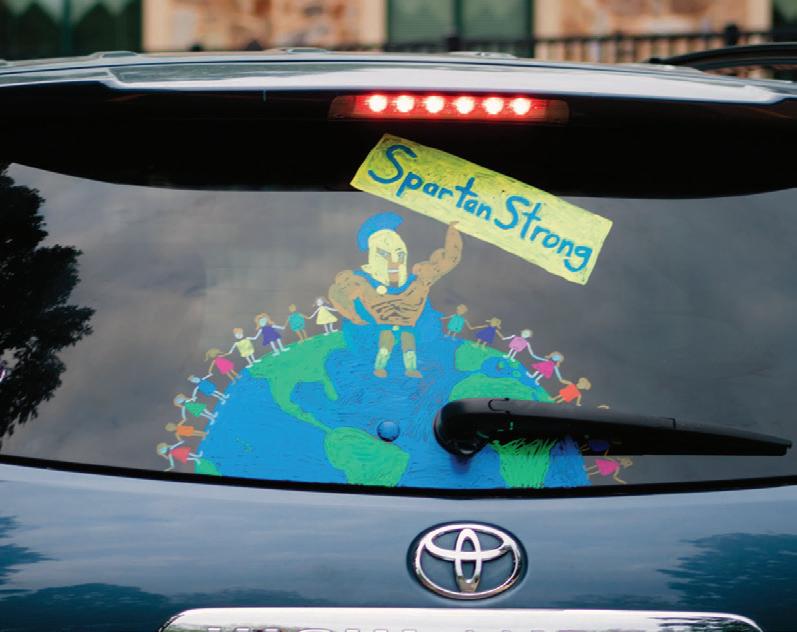
Watch our Face Masks 101 tutorial.

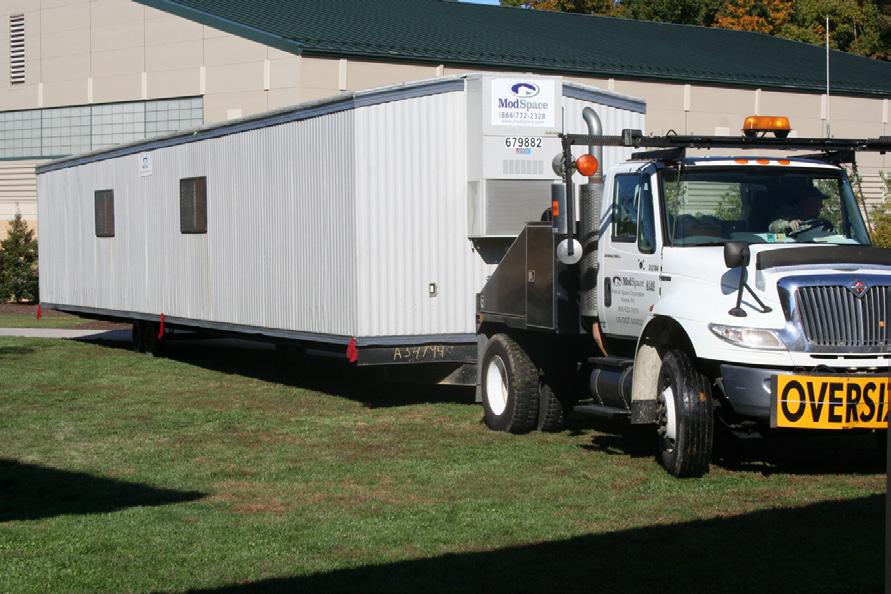
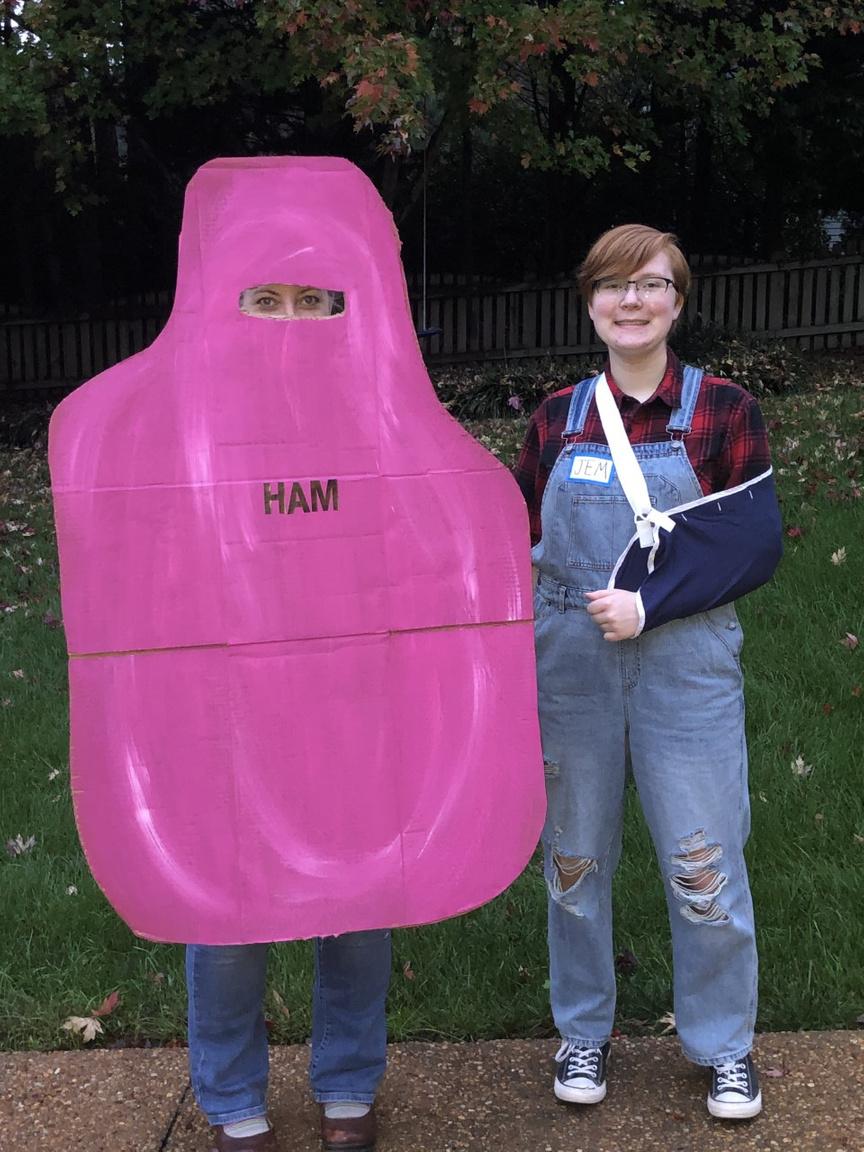

4
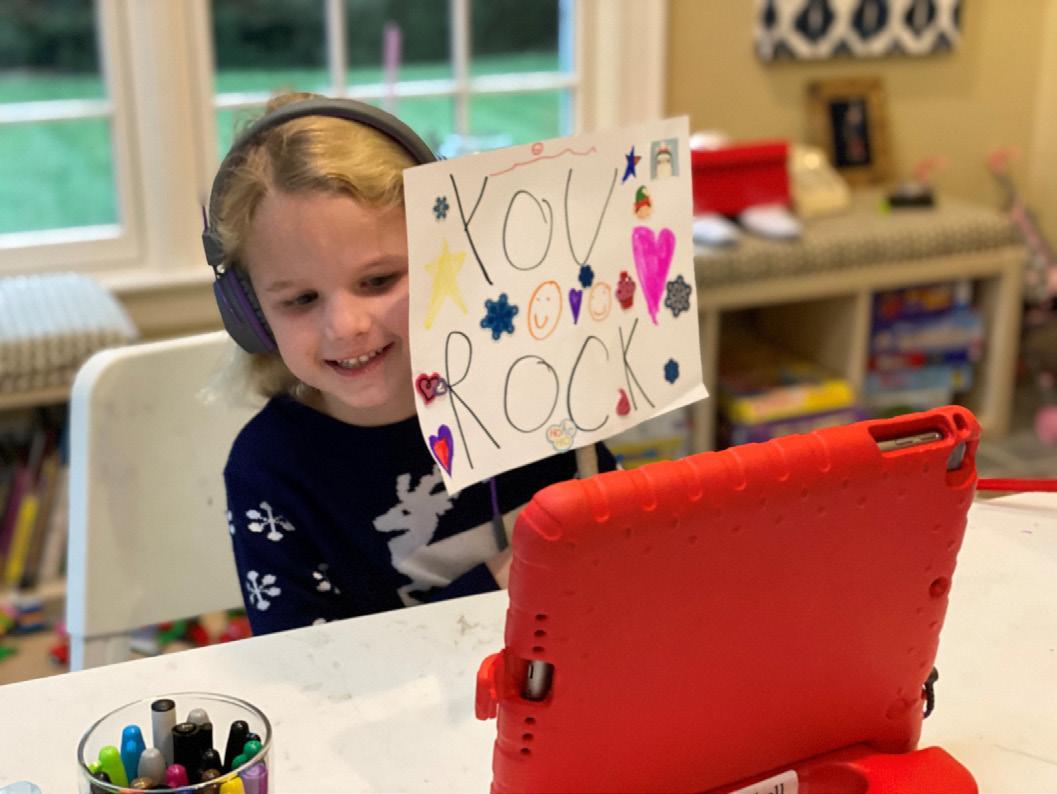
5 7



8 10
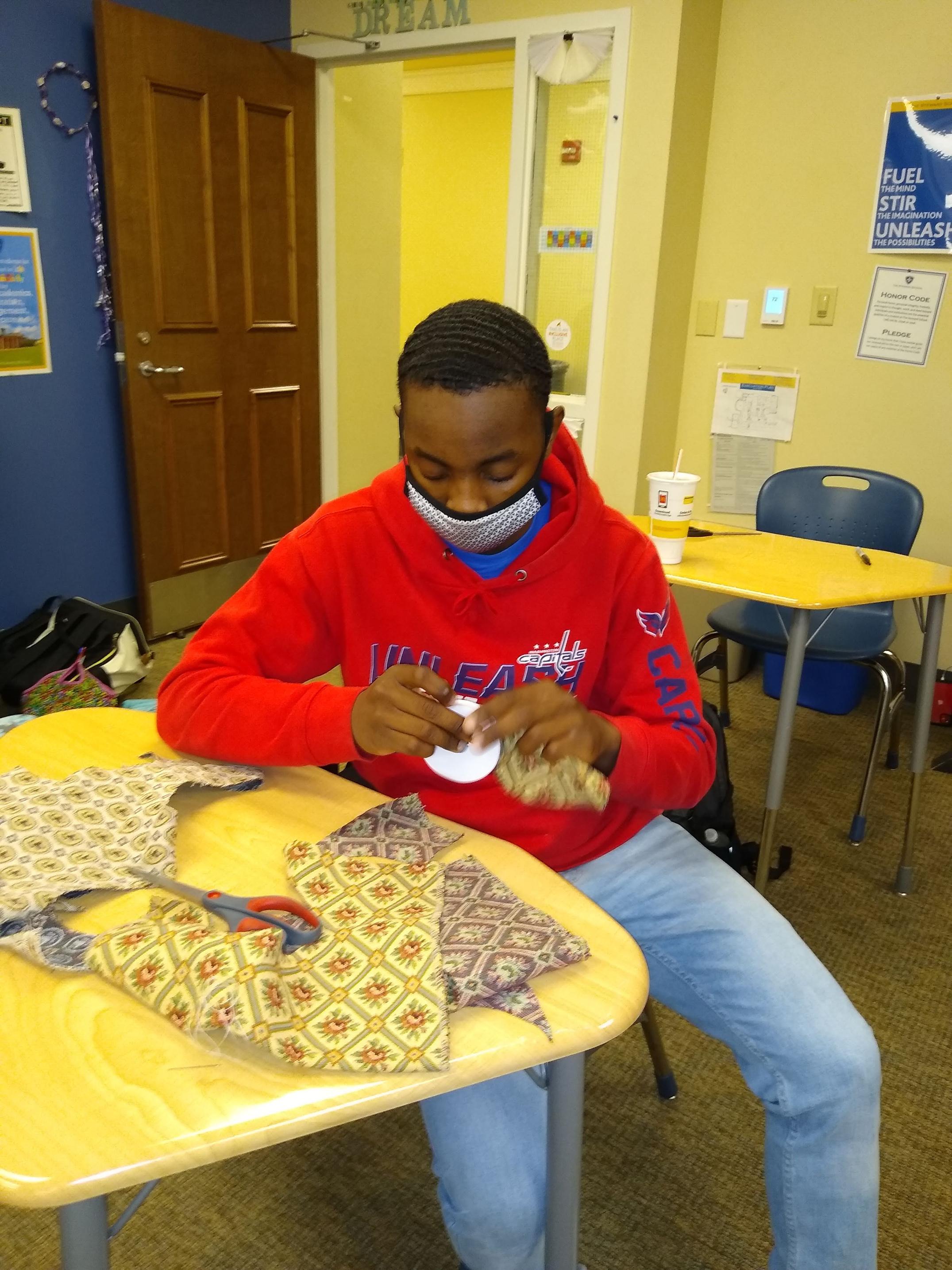

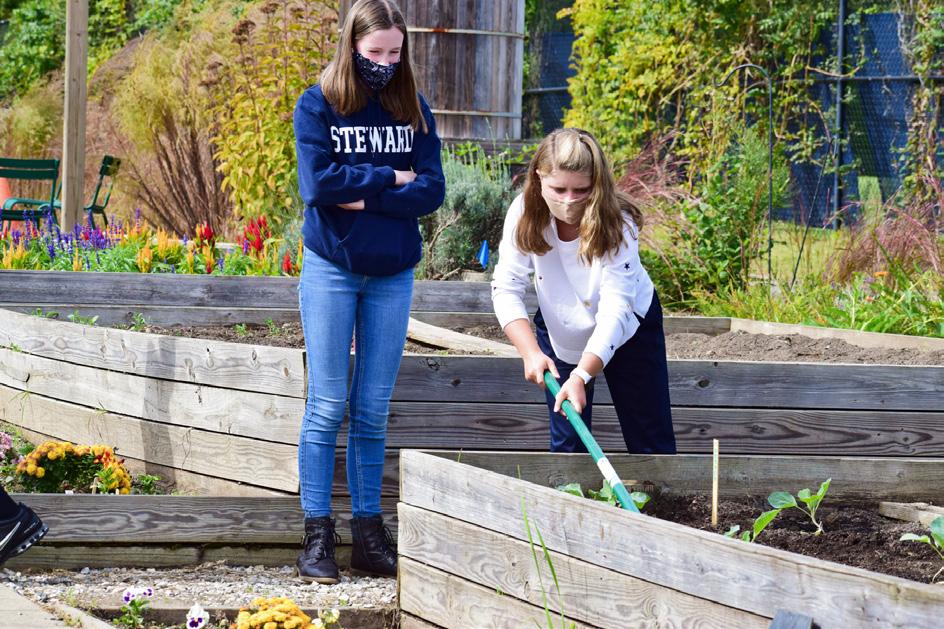
1 The Lower Schoolers got close to their food at the Bryan Innovation Lab while picking cherry tomatoes.
2 The campus receives a makeover with the addition of several learning cottages to open up more classroom space.
3 Upper School English teacher Melissa Calkins and daughter Caitlin Calkins '24 took the literary route for their joint Halloween costume based on "To Kill a Mockingbird." 4 A parent in kindergarten teacher Catherine Hathaway's class organized students to hold up handmade signs thanking their teacher as they logged on to Zoom one morning during Remote Continuous Learning.
5 Lower school theatre and Upper School acting teacher Craig Smith practices lines with students in front of the green screen while recording the third grade class play, "Adding and Rounding Landforms and Landmarks." 6 Lower Schoolers practice their teamwork skills with junior kindergarten teacher Kris Marchant during Lower School Wellness Week.

7 The division directors take their commitment to supporting one another to a whole new level.
8 American Literature students received a hands-on home economics lesson while reading "The Crucible," seen here sewing bonnets for their play production. 9 Middle School students take a break from the classroom to stretch their arms and legs during Community Time.
10 Upper School science teacher Mary Greenlee's environmental science students tend to the Brassica (cruciferous veggies) they planted in the community garden.


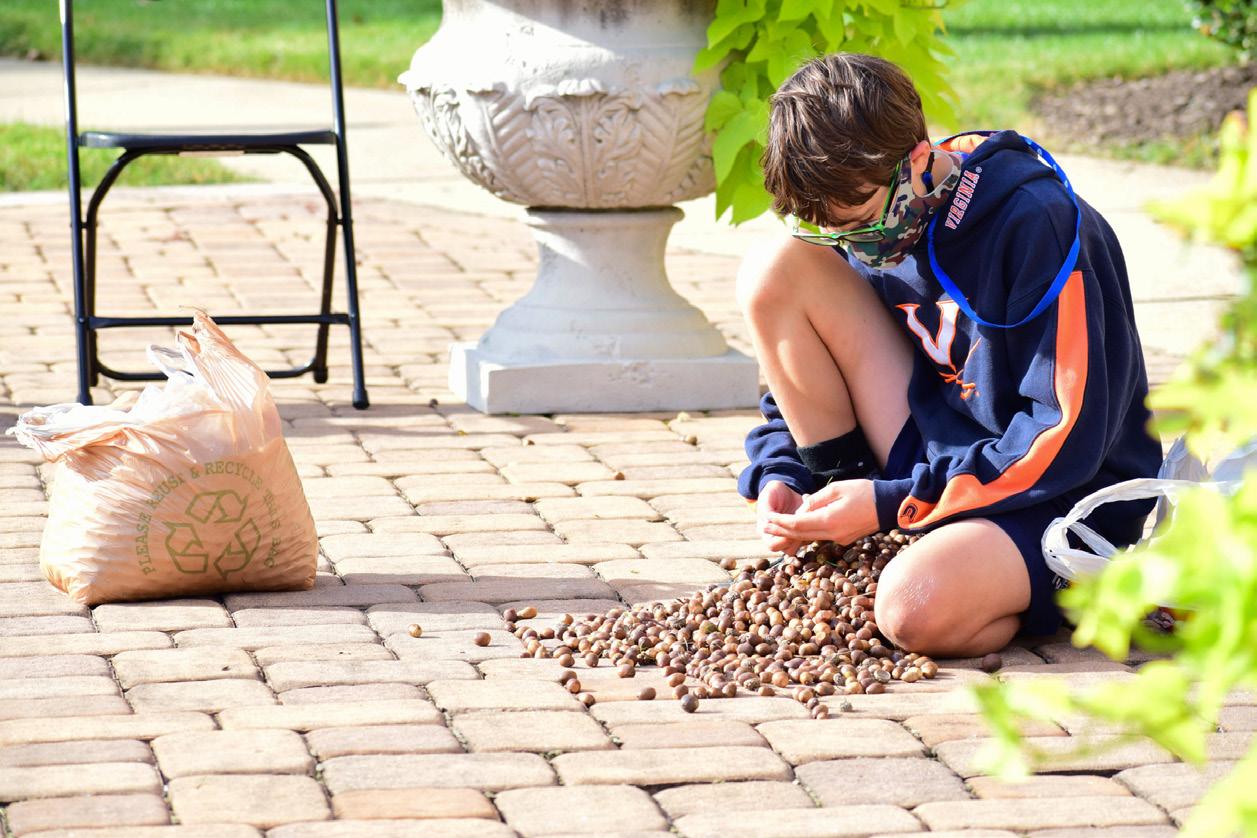
15
16 17 19

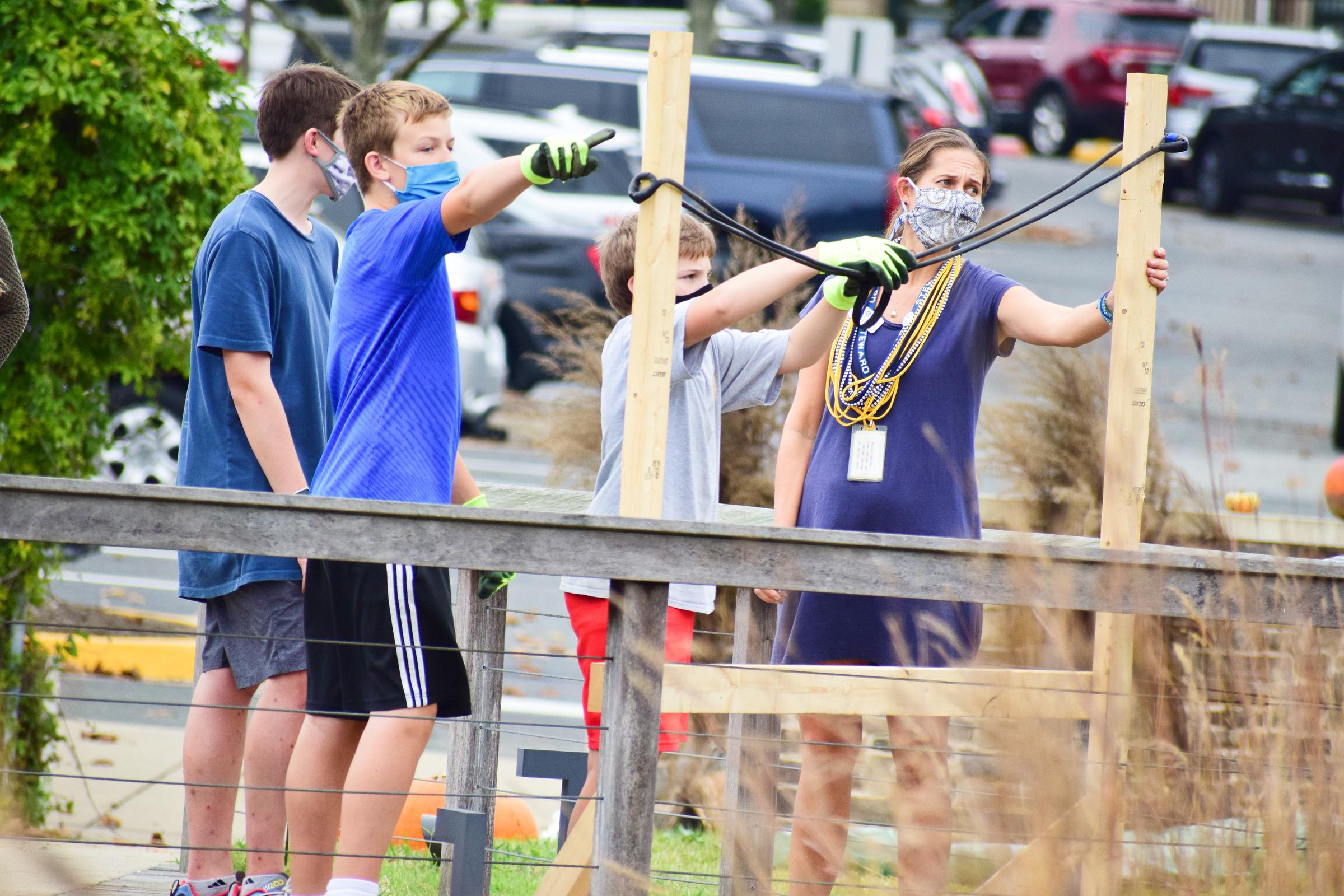

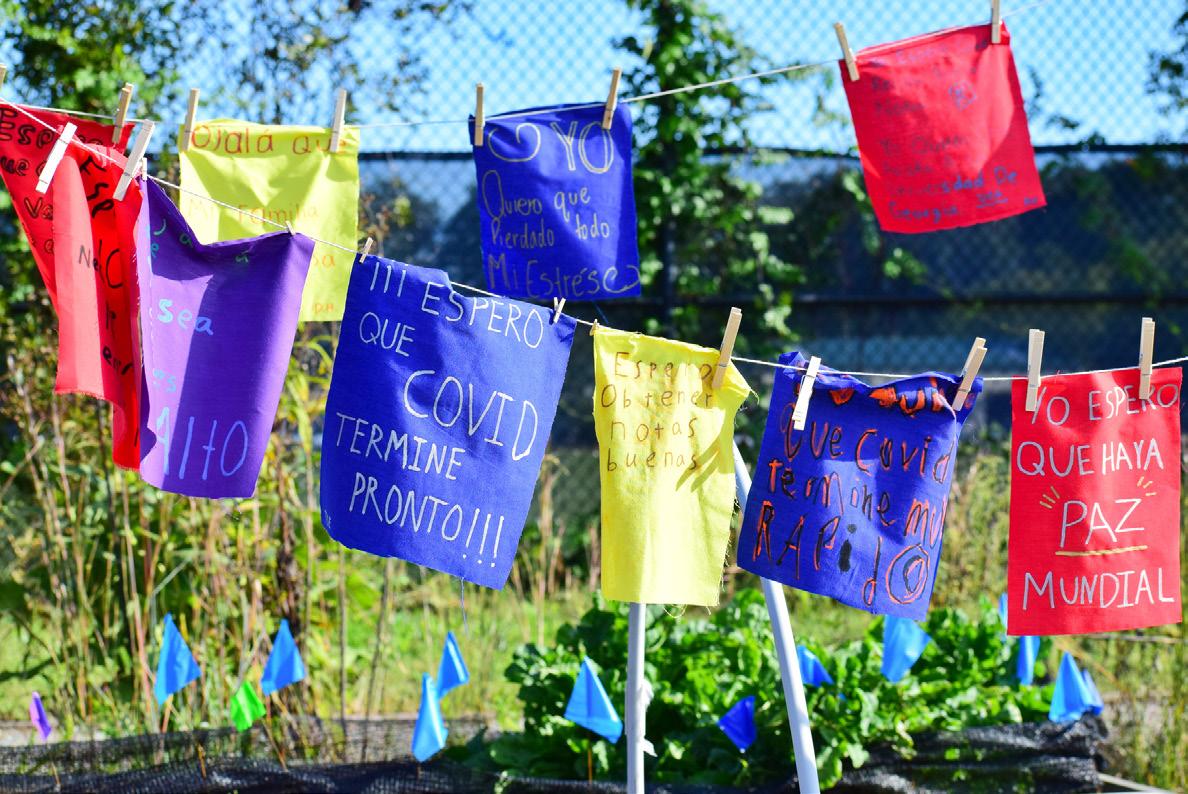


11 Students in Middle and Upper School visual arts teacher Sejal Vaywala's art class make use of the spacious art room to put finishing touches on their portfolios.
12 A student catches some lateafternoon rays while sorting acorns for the Virginia Wildlife Center.
13 Simon says, "Roll around on the floor!" Seniors and their JK/K buddies got to know one another during a rollicking game of Simon Says in the gym. 14 Left to their own "devices," these first grade SAL students kept one another occupied by reading chapter books to one another when the librarian stepped away for a moment.

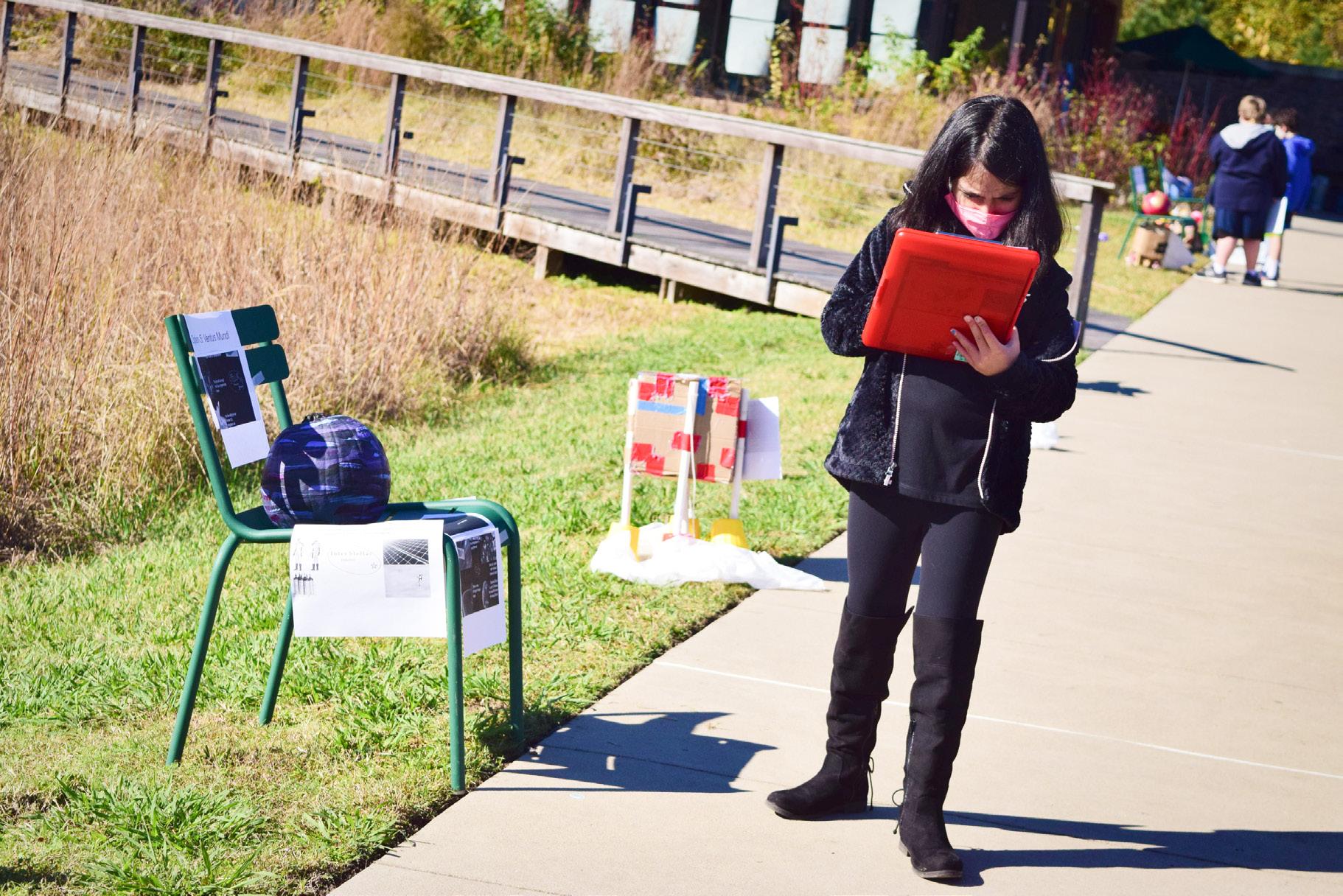
15 Reseeding the meadow was as easy as launching seed bombs from a hand-built slingshot.
16 Health and Wellness Coordinator Michelle Khalife leads sixth graders in a stress-reducing yoga session on the tennis courts. 17 Students voted on which design they thought would best protect a pumpkin dropped from the roof of the Cramer Center during Middle School science teacher Mike Mailey's annual pumpkin drop.
18 Upper School world languages teacher Diana Niemas's Spanish 4 class creates Tibetan prayer flags in connection with a class read. 19 We were able to host our very own pumpkin patch on campus this year thanks to a generous donation from Home Depot and a lot of creativity from our faculty.
IN OUR COMMUNITY: ALUMNI
Reaching Across the Aisle
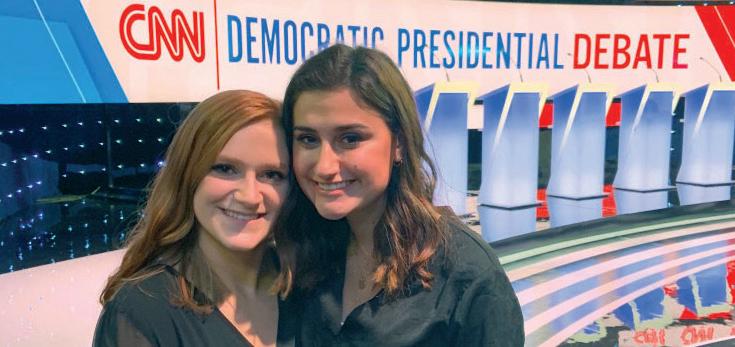
Popular depictions of Iowa highlight its idyllic cornfields and Midwestern agreeableness. But Kara Chalifoux '18 (pictured above right) knows it more for the hefty role it plays in shaping presidential elections.
Early in 2020, Ms. Chalifoux, a junior and political science major at Elon University, was among a handful of students enrolled in the winter term class "The Trail Starts Here: The Iowa Caucuses." Held only in presidential election years, the class offers two weeks of hands-on experience at the Iowa caucuses, allowing political science and journalism students to see the electioneering process up close. For Ms. Chalifoux, that meant everything from canvassing door-to-door to rubbing elbows with high-ranking politicians like former Secretary of State John Kerry (pictured above).
"On my first day, I overheard someone casually mention how [Senator] Cory Booker had just texted him to grab dinner that night," she said. "Where else would you hear that?"
Noteworthy for being the first major contest of the U.S. presidential primary season, the Iowa caucuses are often seen as a strong indicator of how presidential candidates will fare in the upcoming election. Caucusing, which has been used in Iowa since the 1800s, eschews ballot voting for open debate. Voters assemble in churches, libraries, and other public spaces to wrangle over which presidential candidate they support, while politicians make the most of the concentrated political activity by seeking face time with constituents.
"They want to take you to dinner and get to know you," Ms. Chalifoux said. "Voters can bring up topics they care about, and elected officials can elaborate their positions. It's a win-win."
Ms. Chalifoux's political interests began in Steward's Upper School with an offhand comment from her younger brother Michael Chalifoux '20. "We were on a college visit road trip when he casually said, 'Oh, Congressman Dave Brat came to our class and said that anybody who wants an internship should just email him,'" she explained. "And I thought, really? So I emailed him and ended up interning with his campaign three days a week for the entire summer."
Despite working for now-President Joe Biden's campaign — the only student in her class who chose to do so — all of Ms. Chalifoux's previous campaign experience had been with Republican politicians. She believed Biden's views were the most moderate among Democratic candidates, views she felt she would be most able to advocate for with undecided voters.
"I was in the position of canvassing voters who seemed genuinely conflicted over a handful of candidates they felt equally good about," she said. "That made my job more stressful, but a lot more interesting, too."
As she discussed the ins and outs of campaign strategy, Ms. Chalifoux spoke with pride about the Biden team's commitment to not tearing down other Democratic candidates. "We were actually building them up," she said, an approach that served her well among voters weary of political division.

Ms. Chalifoux described her commitment to the campaign as a full-time job ... and then some. Her days generally began with 8 a.m. coordinated door-knocks in 20-degree weather, and ended at 10 p.m. after hours of phone banking. Still, she says the experience was an enlightening, if intense, way to see the varieties of political engagement available to the average voter. She advises those who want to become active to take it one step at a time.
"Decide what matters to you and why," Ms. Chalifoux said. "Do your research to figure out where you stand on the issues. Then decide what you can do about it. It's not always about giving speeches or staging protests. Start small."
